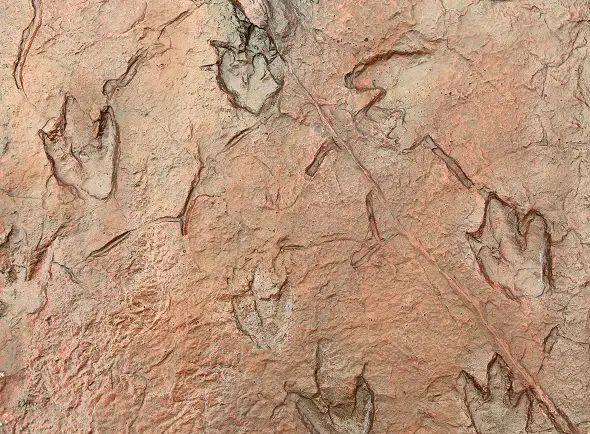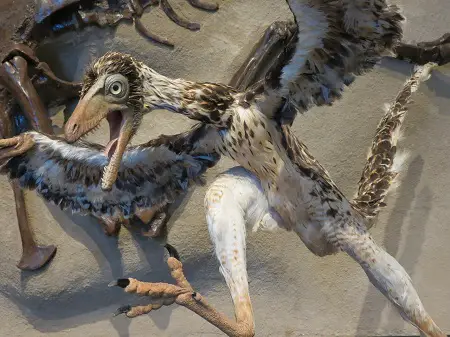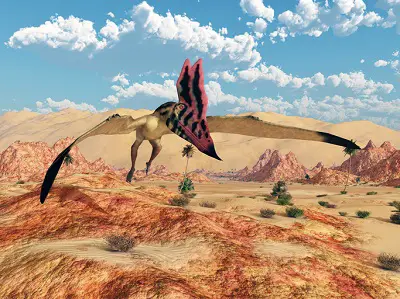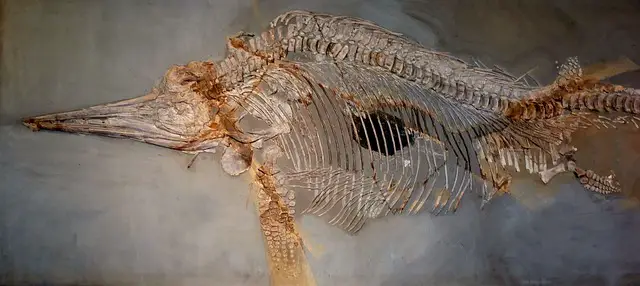What Was The Fastest Dinosaur?
We recently wrote an article on the Gallimimus, an omnivore dinosaur from the Late Cretaceous. While we were researching all the facts about this two legged dinosaur we noticed almost every resource repeated that is was the fastest dinosaur. Although it certainly was fast we thought a little more research was needed to find out what was the fastest dinosaur that ever lived.
Struthiomimus is likely to be the fastest dinosaur on Earth. It is estimated to have achieved speeds of between 30 and 49 miles an hour. (50-70 kph). However, footprints of two unknown galloping theropods (possible Spinosaur or carcharodontosaur) discovered in Northern Spain have a proven speed of 27.7 miles an hour.
In the article below we will explore some of the other types of dinosaurs and see that even if gallimimus and struthiomimus were the fastest dinosaurs, There were other dinosaurs that used four legs, wings or flippers and some of those could turn on the speed when needed.

| Type of Dinosaur | Fastest Member of Dinosaur Family | Top Estimated Dinosaur Speed |
| Biped dinosaurs (2 legs) | Struthiomimus | 30-49 miles an hour |
| Quadruped dinosaurs (4 legs) | Hadrosaur- possible Telmatosaurus | 23 miles a hour |
| Flying Dinosaurs | Archaeopteryx | 10-40 miles an hour |
| Pterosaurs | Quetzalcoatlus | 70 miles an hour plus |
| Carnivore dinosaurs | Unknown theropod | 27.7 miles an hour |
| Swimming Dinosaurs | Spinosaurus | 16 mph lunge and 5,5 mph cruising |
| Marine reptiles ( ichthyosaur / Mosasaur / Plesiosaur) | Ichthyosaur | 4 miles an hour (cruising) |
- These speeds of dinosaurs are of course estimated, sometimes scientifically, sometimes less so. Just so you are aware!
We have an infographic to share and use with some of the fastest dinosaurs and some fast facts about the speeds of dinosaurs. You can click the picture to make it larger or share.
How Do We Measure the Speed of a Dinosaur?
Watching Nature programmes on television they will often talk about how fast animals are, especially if a cheetah makes an appearance. Is easier now to measure speed of animals. However dinosaurs have not been around for 66 million years. So how on earth do we know how fast dinosaurs were, and which one was the fastest?
Well measure how fast dinosaurs comes down to a few factors, science, guesswork and disagreements. As we can’t really give information on the arguments and the guesswork we will highlight the science behind how scientists come up with the figures for dinosaur speeds. Some of these are more accurate than others.
- Fossilized footprints
- Bone Structure
- Compare with animals today
- Computer simulation
- Compare with similar Dinosaurs
Measure the Distance Between Dinosaur Footprints.
There are parts of the world were dinosaur footprints have been discovered, incredibly after so many millions of years. If the dinosaur that produced these footprints is known, and there are enough of them over a given distance then scientists can work out how fast that dinosaur was moving.

This can actually be quite accurate but it is understandably rare to find these sets of footprints. Dinosaurs footprints that have been found like this include A pair of running Theropod dinosaurs, (carnivores on two legs) Found in Northern Spain in that were galloping at around 27.7 miles an hour ( 44 kmph) or as fast as the fastest human can sprint.
This is the fastest provable speed of any dinosaur, unfortunately we are unsure which dinosaur made the tracks, we only know it was around 17 feet long and about 2 meters tall. When pressed for a guess the paleontologists suggested carcharodontosauridae or spinosaurids as both those dinosaur species were known to live in Spain at that time.
It is also interesting to note that they were running on deep mud…. what kind of speed could they have reached if on hard ground!
Bone Structure
it is possible from estimating muscle mass and bone structure ( and density) to work out how fast at a maximum dinosaurs would have been able to run.
With their huge size there was a limit to how much impact force the larger dinosaur bones would have been able to take. The larger and more heavy these dinosaurs were , the slower their tops speeds would have to be.
This is how T-Rexs top speed dropped from 31 miles an hour to just 12. Any faster and its bones would have shattered and broken through the impact of running that fast.
Compare to Animals today
There are laws of movement, and it is possible to compare some dinosaurs to modern day animals. Modern day fish can be compared to prehistoric fish, some reptiles to dinosaurs, even some mammals to long extinct dinosaurs to get an idea of what an animal of a certain size could achieve in terms of speed.
it does not provide definite answers as, for example, a sloth today is about the same size as some dinosaurs and moved considerably slower but it is a starting point to work backwards from and can be used with other methods to provide a reasonably accurate estimate of how fast dinosaurs would run.
Computer simulation
it is possible to put all this information into computers to recreate virtual models of dinosaurs that obey the rules you put into the computer.
This allows the computer to simulate all manner of dinosaur traits, how much it ate, how well it could see and of course how fast the dinosaur could move. This is becoming more and more common as our knowledge base around dinosaurs grows and we can make more accurate predictions.
Dinosaur computer games like Jurassic Park Evolution use this information to simulate their dinosaurs in the games, and on a more scientific scale so do museum’s and universities.
Compare to other dinsaours.
Some dinosaurs have been discovered more often and in greater numbers than others. by comparing to other. more rare, members of the dinosaur family it is possible to suggest that they shared common factors with appearance, behaviour, and abilities.
it is far from foolproof but by being fairly sure of the behavior of one species that is similar to another it is possible to state that a related member of the same family was probably going to be able to run, eat walk, at a similar rate. This is commonly used to say what a dinosaur could or couldn’t do.
Why is Struthiomimus The Fastest Dinosaur?
In the time of the dinosaurs speed was in the hands, or feet, of the two legged dinosaurs – bipeds. If we were to do a list of top 100 fastest dinosaurs it would be 98% dominated by two legged dinosaurs.
Most of these would be herbivores, though those recent research of the two carnivore footprints sets in Spain have challenged that in the last 2 years,
Having faster herbivores is also a fairly normal indication of a healthy prey – predator relationship.
Todays predators are hugely weighted in favour of ambush attacks rather than running down attacks. Even the cheetah exploded from cover it just has faster top speed than anything else. However it is somewhat of an anomaly.
Crocodiles, lions, tigers, wolfs (kinda) really on a quick lunge sprint and kill hunting technique. their pretty usually relies on one of two escape methods. Size or Speed. In the time of the dinosaurs this was similar.
Smaller bipedal herbivore and omnivores like gallimimus, struthiomimus and others looked at sprinting away as fast as their powerful legs could carry them and dinosaurs like ankylosaurus, stegosaurus, the sauropods and triceratops relied on sheet size or armour to dissuade attacks, or to put up a fight if they were attacked.
Struthiomimus was a smaller relative of gallimimus but both had no armour, and despite being large by today’s standards they were small dinosaurs back then. their weapon and their defense was speed, and over millions of years as predators got faster or stronger they got faster and more agile.
Compare that to their four legged dinosaurs, who gained more armor and grew larger but not quicker. Both directions were successful in their own way, one just decided to be the tortoise and one the hare.
Carnivore Dinosaur Top Speeds
- Tyrannosaurus Rex: 12 mph
- Compsognathus: 40 mph
- Allosaurus: 19-34 mph
- Velociraptor: 24 mph
- Carnotaurus – 30-35 mph
Four Legged herbivore Top Speeds
- Diplodocus: 5 to 9 miles an hour
- Ankylosaurus: 6 miles an hour top speed
- Stegosaurus: 5 miles an hour
- Telmatosaurus: 23 miles an hour
- Triceratops: 20 miles an hour
What Were The Fastest Four-Legged Dinosaurs?
Four legged dinosaurs, unlike animals today, were not the fastest of the dinosaurs. In Fact they were petty slow compared to biped ( 2 legs) dinosaurs.
This may have been down to metabolism, warm or cold blood, or their massive size and armour which evolved to be a dissuader to predators rather than speed of their two legged cousins.
The fastest four legged dinosaur, despite the speed of some horned dinosaurs reaching up to 20 miles an hour, was probably a duck billed dinosaur or hadrosaur. One candidate is the telmatosaurus which was a small hadrosaur and would have had the advantage of both agility and speed.

What were the Fastest Flying Dinosaurs
Like the fastest Swimming dinosaurs section below we will have to split this into two sections. Flying dinosaurs and pterosaurs.
Pterosaurs were not dinosaurs, and we go into this in greater detail in a series of articles starting with what were the flying dinosaurs here. However we will include them in the fastest flying dinosaurs here as to 99% of people think they most certainly were dinosaurs.
However, we will start with the flying dinosaurs, of which there are very few. In Fact the only flying, really flying dinosaur considered today is the Archaeopteryx, and possibly less powered more gliding microraptor and sinothinosaurus.
The fastest of these, and basically the only real powered flying dinosaur was the archeopteryx and it wasn’t particular amazing at flying. it is probable that its flight was comparable to modern day birds like pheasants, quail and even potentially chickens.
this means a quick manic flapping of the wings to get height followed by a short horizontal flight to get away from whatever was trying to eat it. it is very unlikely they used this flight ability to hunt or attack. ironically microraptor may have hunted by gliding down, but really flight means flapping wings in our opinion.
the only real estimate of how fast an archeopteryx was is its running speed which was 7 kph or 5 miles an hour.
how fast an archaeopteryx could fly is pure estimation, but if its flight pattern was similar to qual, pheasants and chickens it would have been between 14-60 kph (10 -40 miles an hour). likely at the lower end of these speeds

How Fast Could Pterosaurs fly
Unlike the Archaeopteryx above, pterosaurs were much more suited for like in the air and not only were much faster at flying they would also fly for huge distances and at up to 15,000 feet.
We have more information in our flying dinosaur series of articles here.
The fastest of these, flying dinosaurs was the Quetzalcoatlus. it is also the largest ever flying animal at up to 500lbs and 30ft of wingspan.
It is estimated that Quetzalcoatlus would be able to fly at speeds up to 70 miles an hour when needed, and 55 miles an hour when cruising, Not only could they do this high speed they could keep it up for 8-10 days at a time for ranges between 8-11000 miles!

What is the Fastest Swimming Dinosaur?
There is a long and a short answer to this question.
The short answer is the spinosaurus, as basically it the only known dinosaur to be water based more than land based. there are others that would have hunted at the shore line of rivers and lakes, Baryonyx, Suchomimus and even Ceratosaurus ( article here) that would have not felt totally out of place in water but spinosaurus is the winner by being the only swimming dinosaur at the moment.
How fast could Spinosaurus Swim?
As for a spinosaurus swimming speed, this estimate changed quite frequently but it has been now found to have had a much more evolved tail for swimming, to go with webbing on its limbs and streamlined body, than was thought previously.
This means it would have been much more manoeuvrable in the water and much faster through the water. Currently the estimates, and that’s all they are as they is no footprints to measure for a swimming dinosaur! , have the Spinosaurus being able to swim at around 16-17 miles an hour when lunging forward. Cruising it is thought to be about 5.5 miles an hour.
For reference this is faster than a T-Rex could run on land, and for even more scary reference double what the fastest human has swum ever. With the aid of a monofin Michael phelps raced a shark (losing by a considerable margin) and managed to achieve 8.8 miles an hour.
However to make it even more worrying, if spinosaurus still lived, their estimated top swimming speed would be 8 times the average human swimming speed of 2 miles an hour, that you or I could swim normally.
That is the short answer.
Here is the long answer!
What was the fastest Prehistoric Plesiosaur / marine Reptile?
Swimming Dinosaurs, water Dinosaurs, and Sea Dinosaurs did not exist except for the Spinosaurus. So it will always win a fastest swimming dinosaur contest. it would also win a smallest, biggest, cutest, cleverest, dubest, swimming dinosaur competition, there is no competition!
What most people Call Swimming dinosaurs, scientists call Prehistoric Marine reptiles and we will look which was the fastest of these below. We will cover
- The fastest Ichthyosaur
- The fastest Plesiosaur
- The fastest Mosasaur
How Fast Could an ichthyosaur,
How fast Could a Mosasaurus Swim.
Although it is incredibly difficult to accurately estimate the swimming speeds of long Extinct Sea animals, there are way to get a rough (very) estimate. the mosasaurus is thought to be slower swimmers than both the Plesiosaurs and the ichthyosaurs and a rough cruising speed is put forwards by Judy A. Massare of about 1.8 meters per second which is around 4 miles an hour.
However, these huge marine reptiles were also likely ambush predators so would have been capable of short fast lunges rather than pursuing their prey, so for short bursts they are likely much quicker. Remember even at their slow cruising speed they are still 2 times faster than an average human can swim.
How fast could a plesiosaur swim?
As is mentioned in the article quoted above “Long-bodied reptiles appear to have had slower sustained swimming speeds than deep-bodied forms of the same length.”
So plesiosaurus were also not going to break any speed records, at least at their everyday speeds. It is thought that like Mosasaurs they were sedate swimmers, relying on short bursts, and that long neck, to grab fish by surprise.
if we take the middle of the estimates above then it would put them at around 1.5 meters per second or about 3.4 miles an hour.

How fast could an Ichthyosaur swim?
It is thought that an Ichthyosaurus was potentially the fastest fo the marine reptiles, but those estimates are hugely varied from 40 km per hour to about 6 km per hour. research done by Montani n 2002 is the most recent research undertaken and suggests the lower speeds are more likely.
If correct then the swimming speed of an ichthyosaur would be about 1.8 meters a second or 4 miles an hour.
Note: All of these animals would have been able to do short burst of speeds to catch prey or to evade a predator. if you watch a cheetah walking in Africa it is not pelting around at 70 miles an hour for all its waking day, they turn on the speed when they need to, not all the time!
Conclusion
There is competition for the title of fastest dinosaur. Without definite proof it is thought to be the struthiomimus due to its ostrich like build and legs built for running, and its smaller size than gallimimus.
However the discovery of the theropod footprints in Northern spain has opened up the debate on how fast larger bipeds could actually run as 27 miles an hour is really fast, and much faster than was thought for predator bipeds of this size. it also has to be remembered they were running in mud!
Get them on a racetrack and who knows!
references
https://peerj.com/articles/3420/
https://ucmp.berkeley.edu/diapsids/buzz/locomotion.html
https://www.nationalgeographic.com/science/article/tyrannosaur-trex-running-speed
Hi, I am Roy Ford a General Studies and English Teacher who has taught all over the world. What started as a fossil collection became a great way to teach, motivate and inspire students of all ages and all over the world about dinosaurs and from that and children’s love of dinosaurs came the site dinosaur facts for kids, a resource for all ages.











